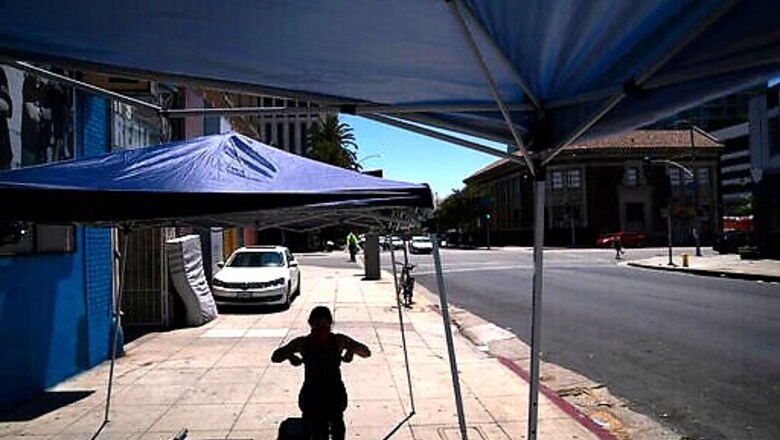
views
SACRAMENTO, Calif.: California will begin sending 40% of all vaccine doses to the most vulnerable neighborhoods in the state to try to inoculate people most at risk from the coronavirus and get the states economy open more quickly, Gov. Gavin Newsom said Thursday in the latest shake-up to the state’s rules.
The doses will be spread among 400 ZIP codes where there are about 8 million people eligible for shots, said Dr. Mark Ghaly, the state’s health and human services secretary. Many of the neighborhoods are in Los Angeles County and the central valley, which have had among the highest rates of infection.
The areas are considered most vulnerable based on metrics such as household income, education level and access to health care. Newsom said that not only is this the right thing to do, it’s critical to opening up more of the state’s economy.
It is a race against the variants. It’s a race against exhaustion. It’s a race to safely, thoughtfully open our economy, mindful that it has to be an economy that doesn’t leave people behind, that is truly inclusive, Newsom, a Democrat, said at a news conference. He also encouraged people to wear two masks.
The announcement is the latest change in an evolving approach to getting nearly 40 million residents vaccinated, adding to ongoing confusion among people clamoring for shots. The move to ease reopening also comes days after several Republican-led states lifted COVID-19 restrictions as the U.S. now has three vaccines available.
Tying reopening to vaccination equity metrics was cheered by representatives of the legislative Black and Latino caucuses, as well as social justice and equity groups. Latinos make up roughly half of cases and deaths in California even though they are 39% of the population.
Dr. Sergio Aguilar-Gaxiola, director of the UC Davis Center for Reducing Health Disparities, said the dedicated vaccine hasn’t come soon enough given the disparate numbers of deaths and the lack of access to vaccines in the hardest hit communities.
They are living day-to-day, so they have to go and work in order to survive and they dont have the luxury to take half a day to go where the vaccine sites are, he said.
The current standards for who can get a vaccine won’t change. Right now that’s people 65 and over, farmworkers and grocery clerks, educators and emergency service workers. Transit workers, flight attendants and hardware store clerks are among those clamoring to be added to the priority access list.
I wouldnt say its not fair, but it should be thought out a little bit more,” said Lee Snyder, assistant manager at Brownies Ace Hardware in San Francisco.
Setting aside 40% of vaccine supply essentially means that hard-hit ZIP codes will be administering double what they are currently, Ghaly said. Data show that of shots given, only about 17% were administered in vulnerable communities that have been disproportionately affected by the pandemic.
Double that amount was going to those in the top quarter of what California deems the healthiest communities, Ghaly said.
Newsom has called equity the states North Star. Yet community health clinics that serve low-income and vulnerable Californians say they havent been getting enough doses and are hopeful that will change. Ghaly said Thursday that the administration will work with communities to make sure the vaccine gets to those patients, not to day-trippers from wealthier ZIP codes who have the time and tech savvy to schedule appointments online. Newsom said addressing the problem is like playing whack-a-mole.
The health centers want to protect appointments for patients and others from underserved communities to ensure those people we are targeting are coming, not the vaccine seekers” from wealthier neighborhoods, said Andie Martinez Patterson, vice president of government affairs at the California Primary Care Association. She said a recent South Los Angeles clinic recently found its appointments had been booked by people from Beverly Hills.
Ghaly said that people with certain disabilities or underlying health conditions who will be eligible in mid-March will not be left out, as many live in some of the disadvantaged areas. He said he expects all communities to receive at least as many doses of vaccine as they’re receiving now.
As more doses are administered in the targeted neighborhoods, the state will make it easier for counties to move through tiers that dictate business and school reopenings.
Right now, counties can move from the most restrictive purple tier to the lower red tier based on metrics including the number of new COVID-19 cases per 100,000 people per day over a period of several weeks. The strict standard for that rate will be lowered, allowing businesses such as restaurants and gyms to reopen indoors at limited capacity.
While race and ethnicity are not explicit factors in designating vaccinations, the 400 vulnerable ZIP codes overlap heavily with neighborhoods with higher populations of Blacks, Latinos and Asian and Pacific Islanders, officials said.
___
Har reported from San Francisco.
___
Associated Press writer Amy Taxin in Orange County contributed to the story.
Disclaimer: This post has been auto-published from an agency feed without any modifications to the text and has not been reviewed by an editor
Read all the Latest News, Breaking News and Coronavirus News here




















Comments
0 comment